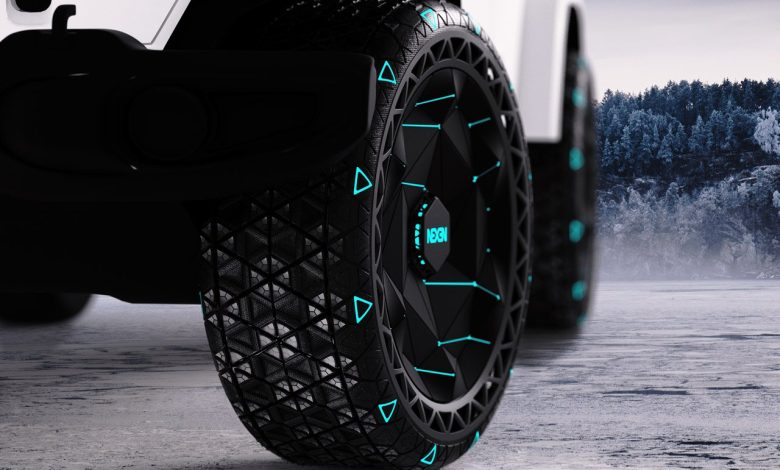Smart Tires Transform Vehicle Safety

The automotive industry is undergoing a technological transformation, and smart tires are at the forefront of this evolution. These intelligent, sensor-equipped tires are changing how vehicles interact with the road, offering real-time monitoring, enhanced safety, and predictive maintenance. This in-depth guide explores how smart tires work, their benefits, top brands, and why they represent the future of driving safety.
What Are Smart Tires?
Smart tires are next-generation tires embedded with sensors and connectivity features that provide real-time data on:
A. Tire Pressure Monitoring
-
Automatically alerts drivers of underinflation or overinflation.
-
Prevents blowouts and improves fuel efficiency.
B. Tread Wear Analysis
-
Tracks tread depth to warn of bald spots before they become dangerous.
-
Extends tire lifespan with timely rotation recommendations.
C. Temperature & Load Sensing
-
Monitors heat buildup to prevent overheating.
-
Adjusts for heavy loads to maintain optimal performance.
D. Road Condition Detection
-
Identifies wet, icy, or uneven surfaces.
-
Sends alerts to the driver or adjusts vehicle stability control.
How Smart Tires Improve Vehicle Safety
Smart tires prevent accidents before they happen through AI-powered analytics and real-time feedback. Here’s how they enhance safety:
1. Preventing Tire Blowouts
-
70% of tire-related accidents are due to improper inflation.
-
Smart sensors detect pressure drops before a blowout occurs.
2. Optimizing Traction in Bad Weather
-
Detects hydroplaning risks on wet roads.
-
Adjusts braking systems for better grip on ice.
3. Reducing Braking Distance
-
Properly inflated tires shorten stopping distance by up to 20%.
-
AI predicts skid risks and adjusts ABS accordingly.
4. Enhancing Fuel Efficiency
-
Underinflated tires increase fuel consumption by 3%.
-
Smart tires maintain ideal pressure, saving money and emissions.
5. Predictive Maintenance Alerts
-
Warns before tread wear becomes hazardous.
-
Suggests optimal rotation schedules for even wear.
Top 5 Smart Tire Brands in 2025

Several leading manufacturers are pioneering smart tire technology. Here are the best options available today:
A. Michelin – Uptis (Airless & Smart)
✅ Key Features:
-
Puncture-proof airless design.
-
Embedded sensors for pressure & wear tracking.
-
Connected to vehicle telematics.
Best For: Drivers in rough terrain or urban areas with potholes.
B. Goodyear – SightLine
✅ Key Features:
-
AI-powered tread & pressure monitoring.
-
Cloud-connected for fleet management.
-
Self-regulating pressure for different road conditions.
Best For: Fleet operators and long-haul truckers.
C. Pirelli – Cyber Tire
✅ Key Features:
-
Integrates with car’s ADAS (Advanced Driver Assistance Systems).
-
Detects road surface changes in real-time.
-
Works with Ferrari, BMW, and Tesla.
Best For: Luxury and performance vehicles.
D. Bridgestone – SmartWear
✅ Key Features:
-
Self-sealing technology to prevent flats.
-
Bluetooth-enabled pressure alerts.
-
Tracks driving habits for personalized feedback.
Best For: Everyday commuters and rideshare drivers.
E. Continental – ContiSense
✅ Key Features:
-
Uses conductive rubber to detect punctures.
-
Sends instant alerts to the driver’s phone.
-
Works with electric and autonomous vehicles.
Best For: EV owners and tech-savvy drivers.
Smart Tires vs. Traditional Tires: Key Differences
| Feature | Smart Tires | Traditional Tires |
|---|---|---|
| Pressure Monitoring | ✅ Real-time alerts | ❌ Manual checks needed |
| Tread Wear Tracking | ✅ AI-powered analysis | ❌ Visual inspection required |
| Road Condition Feedback | ✅ Adjusts vehicle systems | ❌ No interaction with car’s computer |
| Maintenance Alerts | ✅ Predictive notifications | ❌ Reactive fixes after damage |
| Cost | ⚠️ Higher initial price | 💲 Cheaper upfront |
Verdict: Smart tires save money long-term by preventing accidents and improving efficiency.
Challenges & Limitations of Smart Tires
Despite their advantages, smart tires have some current limitations:
A. Higher Upfront Cost
-
20-30% more expensive than conventional tires.
-
Justified by long-term savings on fuel and maintenance.
B. Battery & Connectivity Dependence
-
Sensors require power (some use energy harvesting).
-
Bluetooth/Wi-Fi needed for real-time updates.
C. Limited Aftermarket Support
-
Best performance when paired with compatible vehicles.
-
Older cars may need additional hardware.
The Future of Smart Tires
By 2030, smart tires are expected to:
-
Integrate with autonomous driving systems.
-
Use self-healing materials to repair minor punctures.
-
Generate electricity from friction to power sensors.
Major automakers (Tesla, Toyota, Mercedes) are already adopting smart tires as standard.
Should You Upgrade to Smart Tires?
✅ Yes, If You:
-
Prioritize safety & accident prevention.
-
Drive long distances or in extreme weather.
-
Own a modern, connected vehicle.
❌ Wait, If You:
-
Have an older car without telematics.
-
Are on a tight budget (prices will drop by 2025).
Final Verdict: Smart Tires Are the Future

Smart tires represent the biggest leap in tire technology since radial tires. With real-time monitoring, predictive safety features, and AI-driven adjustments, they are set to become standard in all vehicles.
For maximum safety, efficiency, and peace of mind, upgrading to smart tires is a smart investment.